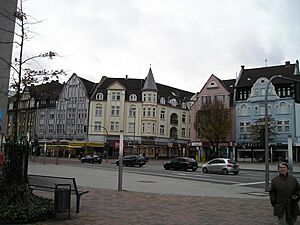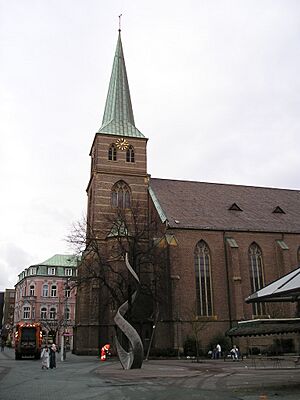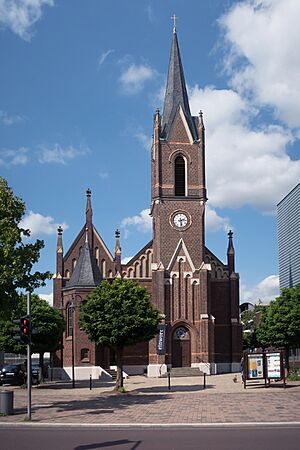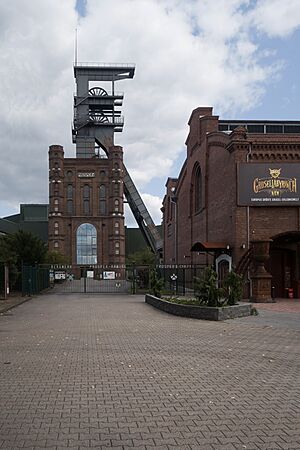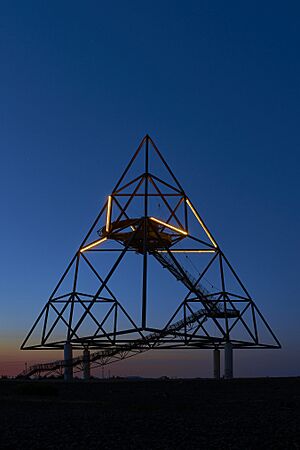Bottrop facts for kids
Quick facts for kids
Bottrop
|
|||
|---|---|---|---|
|
|||
| Country | Germany | ||
| State | North Rhine-Westphalia | ||
| Admin. region | Münster | ||
| District | Urban district | ||
| Elevation | 60 m (200 ft) | ||
| Population
(2022-12-31)
|
|||
| • Total | 118,113 | ||
| Time zone | CET/CEST (UTC+1/+2) | ||
| Postal codes |
46236–46244
|
||
| Dialling codes | 02041, 02045 | ||
| Vehicle registration | BOT | ||
Bottrop is a city in west-central Germany. It is located on the Rhine–Herne Canal in the state of North Rhine-Westphalia. Bottrop is part of the Ruhr area, which is a big industrial region. It is close to other cities like Essen and Oberhausen.
Bottrop used to be a major center for coal mining and trains. Factories in the city made things like chemicals, textiles, and machines. The city started growing a lot because of mining in the 1860s. It officially became a city in 1921.
In 1975, Bottrop joined with two nearby towns, Gladbeck and Kirchhellen. But Gladbeck left in 1976. Since then, Kirchhellen has been a part of Bottrop. Bottrop is also connected to Blackpool, England, as a twin city.
Contents
City Areas
Bottrop covers an area of about 101 square kilometers (39 square miles). From north to south, it is about 17 kilometers (11 miles) long. From west to east, it is about 9 kilometers (6 miles) wide. The highest point in the city is 78 meters (256 feet) above sea level. The lowest point is 26 meters (85 feet) above sea level.
Bottrop is split into three main parts, called boroughs:
- Bottrop-Mitte (which means Bottrop-Center)
- Bottrop-Süd (Bottrop South)
- Bottrop-Kirchhellen
Each of these boroughs has its own local government. These boroughs are then divided into smaller areas. Some of these smaller areas have old traditional names. Newer parts of the city have been named more recently.
Here are some of the smaller areas in each borough:
- Bottrop-Mitte: Eigen, Fuhlenbrock, Stadtmitte, and Marktviertel
- Bottrop-Süd: Batenbrock, Boy, Ebel, Lehmkuhle, Vonderort, Gartenstadt Welheim, and Welheimer Mark
- Bottrop-Kirchhellen: Ekel, Feldhausen, Grafenwald, Hardinghausen, Holthausen, Im Loh, Kirchhellen, Kuhberg, and Overhagen
About Kirchhellen
Kirchhellen was its own town from 1919 until 1976. In 1975, it joined Bottrop along with Gladbeck. People even called the new, bigger city "GlaBotKi" for a short time. But Gladbeck left Bottrop in 1976. After that, Kirchhellen became a district of Bottrop.
Most people in Kirchhellen are Catholic, about 65%. It has three churches, including one Lutheran church.
Fun Things to See and Do
Buildings and Museums
Bottrop has many interesting buildings and places to visit:
- The Quadrat Bottrop is a museum. It shows the history of the local area. It also has art by Josef Albers and other artists.
- The City Hall is a beautiful building built between 1910 and 1916. It is seen as a symbol of the city.
- Schloss Beck is an old castle built in the 1700s. Today, it is a fun theme park!
- The Alte Apotheke (Old Pharmacy) is a historic building from 1895.
- There are many churches in Bottrop, both Catholic and Protestant. Some notable ones include St. Cyriakus and Martinskirche.
- The Malakow-Turm is an old tower from a coal mine, built in 1872.
- The Coal Mining Tip Haniel is a special hill made from mining waste. It has an open-air theater and a walking path with art.
Cool Attractions
- Alpincenter is the longest indoor ski slope in the world! You can go skiing or snowboarding there.
- The Tetraeder is a 50-meter (164-foot) tall steel structure. It looks like a giant pyramid and you can walk up it! It sits on top of a 90-meter (295-foot) tall hill. It has been a famous landmark since 1995.
- Movie Park Germany is a big theme park located in Bottrop-Kirchhellen. It has many rides and shows.
- Indoor Skydiving Bottrop has a powerful vertical wind tunnel. People from all over Europe come here to experience what it feels like to skydive indoors.
- Since 2005, special small plaques called Stolpersteine (stumbling stones) have been placed around the city. They remember people who were treated unfairly during a difficult time in history.
Events and Festivals
Bottrop has many exciting events throughout the year:
- Festival Orgel PLUS is a music festival that started in 1989. It happens in January.
- In February, there is a big Rose Monday Parade for Carnival.
- The Horse Market takes place in May.
- Also in May, you can find the Asparagus - Farmers' Market in Kirchhellen.
- The Brezelfest (Pretzel Festival) is another fun event in Kirchhellen.
- During May, June, and July, there are many Schützenfeste (marksmen festivals) held by different local groups.
- In September, the Michaelismarket is a popular event.
Religion
In Bottrop, about 50% of people are Catholic. There are 19 Catholic churches. About 20% of people are Protestant (Lutheran), and there are 8 Protestant churches. Around 20% of people do not follow a specific religion. About 2% of the population is Muslim.
Famous People from Bottrop
Many talented people were born or lived in Bottrop, including:
- Josef Albers (1888–1976), a famous painter and artist.
- August Everding (1928–1999), a well-known director for opera.
- Theo Jörgensmann (born 1948), a jazz musician and composer.
- Ulla Kock am Brink (born 1961), a television presenter.
- Werner Münch (born 1940), a politician who was a prime minister of a German state.
Twin Cities
Bottrop is twinned with several cities around the world. This means they have special friendly relationships and often exchange visits and ideas.
 Blackpool, England, United Kingdom (since 1980)
Blackpool, England, United Kingdom (since 1980) Gliwice, Poland (since 2007)
Gliwice, Poland (since 2007) Merseburg, Germany (since 1989)
Merseburg, Germany (since 1989) Mitte (Berlin), Germany (since 1983)
Mitte (Berlin), Germany (since 1983) Tourcoing, France (since 1967)
Tourcoing, France (since 1967) Veszprém, Hungary (since 1987)
Veszprém, Hungary (since 1987)
See also
 In Spanish: Bottrop para niños
In Spanish: Bottrop para niños




